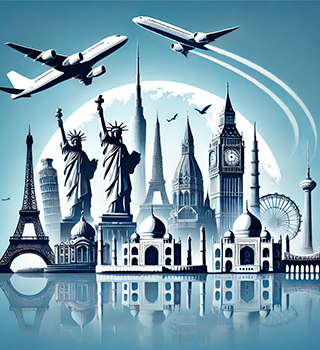Information on Guadalajara

History
The city is named after the Spanish city of Guadalajara, with the name originating from the Arabic wād al-ḥaŷara (واد الحجارة o وادي الحجارة), meaning “Valley of Stones”; the literal translation of the Iberian name (Arriaca), meaning “stony river”. The native name for the Guadalajara valley, Atemajac, in Nahuatl language, seems to be also related to this meaning, from atl (water), tetl (stone), and maxatli (to bifurcate), i.e. “stone bifurcating the water”, in reference to the river crossing the old city (San Juan de Dios river, now flowing under the Calzada Independencia avenue), or perhaps in reference to the monumental cliff (in Spanish “farallón”) emerging from the Oblatos canyon, limiting the North of the valley.
Guadalajara was founded in 1531 by the Spanish explorer Cristóbal de Oñate, who had been commissioned by the conquistador Nuño de Guzmán. The original settlement consisted of 42 inhabitants settled on the Mesa del Cerro, near the border with Nochistlán in the province of Teúl, known today as San Juan de Los Lagos.
The name Guadalajara came from the birthplace of Nuño de Guzmán in Spain. Guzmán and Cristóbal de Oñate decided to relocate to a place with more water, fewer dust storms, and better transportation. They began this project in May 19, 1533, and by August 8,1533 they had moved the town to its second location, near Tonalá. Two years later, in March 1535, they again moved the town to a new location. On November 8, 1539 the emperor Charles V granted a coat of arms and the title of City to Guadalajara.
After a serious attack by indigenous Mexicans in September 28, 1541 during the War of the Mixtón, it was decided once more to relocate the city and re-establish it again in the Atemajac Valley.
Today’s city of Guadalajara was founded at this site by Crístobal de Oñate on February 14, 1542, by Royal decree of King Charles V. During the Colonial era, Guadalajara became the capital of Nueva Galicia and prior to the War of Independence it was the capital of the Intendencia of Guadalajara.
With a population of around six million, Guadalajara is the second largest city in Mexico and can be considered the most stereotypically Mexican city, especially when one considers its contributions to Mexican culture: tequila, mariachis and the charco (sombrero) hat. Although Guadalajara harbors strong traditions and abundant history in its numerous museums and historic architecture, it is also a modern and industrial city and offers a high quality of life relative to most Mexican urban centers.
In a “Cities of the Future” survey by fdimagazine, Guadalajara was the highest ranking Mexican city and has the second strongest economic potential of any major North American city, with only Chicago scoring higher. The geographical location of Guadalajara and its communications infrastructure make it very favorable for commerce with the rest of the country, and also attracts investors and commerce worldwide.
The Metropolitan Zone of Guadalajara has several commercial centers; the city is the national leader in development and investment in commercial centers. Guadalajara is home to one of the greatest malls in Latin America: Galerias Guadalajara 360. The current boom of construction and fast development is one of the most important periods in the history of this city. Its cultural wealth has taken an important role in the tourist sector; many of the main cultural events of the country are hosted here. Guadalajara is a main destination for people who visit Mexico.
Cost of Living
Due to its importance as the major industrial and commercial center of western Mexico, Guadalajara has a large community of expatriates. Since the first major step in relocating to Mexico is to find housing, expats generally select their residential area based on proximity to work and/or school, as well as on issues of security, pollution and services such as shops and hospitals.
Atlas Colomos, Ciudad Bugambilias, Club de Golf Santa Anita, Colinas de San Javier, Country Club, Lomas del Valle, Providencia, Puerta de Hierro, Rancho Contento and Valle Real are the main areas of town where expatriate families live. These communities offer the security and comfort that expatriates expect, often being gated or high-walled residences with security guards, and have excellent sporting facilities (golf, gym, swimming), along with proximity to shops, supermarkets and schools. The monthly rent for a house in any one of these residential areas generally ranges from US$1,400 to US$2,300.
Modest medical fees also mean that foreigners can pay for hospital expenses straight out of their pocket, while national health insurance costs around US$400 a year.
Climate
Under the Koppen climate classification, Guadalajara has a humid subtropical climate, featuring dry and mild winters and warm and wet summers. Guadalajara’s climate is influenced by its high altitude and the general seasonality of precipitation patterns in western North America.
Although the temperature is mild year-round, Guadalajara has very strong seasonal variation in precipitation. The North American Monsoon brings a great deal of rain, whereas for the rest of the year, the climate is very arid. The extra moisture in the wet months moderates the temperatures, resulting in cooler days and warmer nights during this period. The highest temperatures are usually reached in May averaging 32°C, before the onset of the wet season. March tends to be the driest month and July the wettest, with an average of 249 millimetres (9.8 in) of rain, over a quarter of the annual average of about 921 millimetres (36.3 in).
The Culture in Guadalajara
Guadalajara is a city of tradition, and popular activities include the charrería and mariachi music, and these are celebrated at the International Mariachi and Charrería Fair in the month of September.
Furthermore, our city is home to diverse cultural activities of national and international importance, a good example being the Fería Internacional del Libro (the International Book Fair), which is one of the most important at a world level and the most important in respect of the Spanish language. Another notable cultural event is the International Film Festival in our city.
Guadalajara has been recognized for its historical centre, replete with old, classical buildings, amongst these being the Degollado Theatre, the regional and city museums, the Government Palace, the Cruz de Plazas, the Cathedral and the Cabañas Cultural Institute, the latter having been named as a National Heritage of Humanity by UNESCO.
In the centre of Guadalajara one can enjoy the beauty of the old, colonial buildings and visit the cultural and recreational centres, such as the museums and theatres. Because of this and for the care that the city has shown in preserving and promoting its culture, Guadalajara was designated as the Capital of American Culture in 2005.









